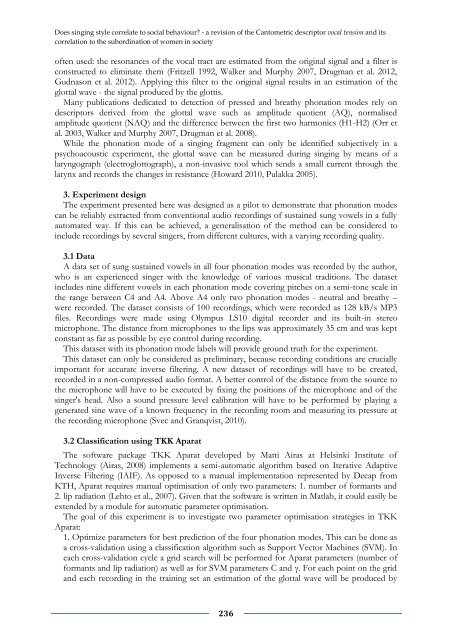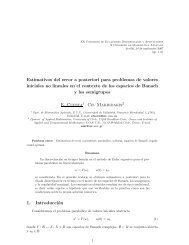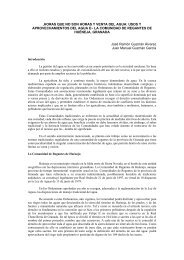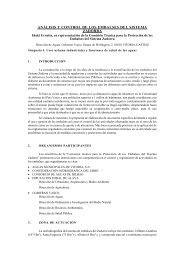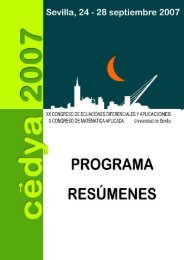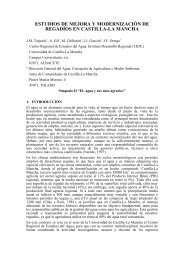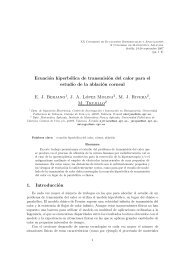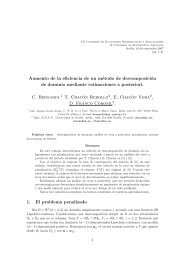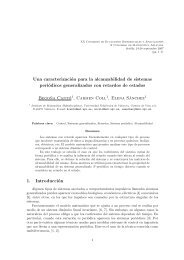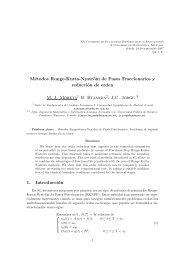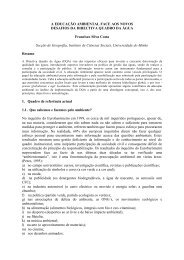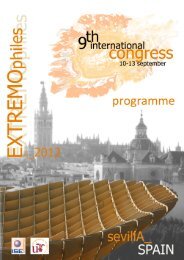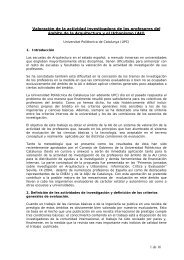LIBRO DE ACTAS (pdf) - Universidad de Sevilla
LIBRO DE ACTAS (pdf) - Universidad de Sevilla
LIBRO DE ACTAS (pdf) - Universidad de Sevilla
You also want an ePaper? Increase the reach of your titles
YUMPU automatically turns print PDFs into web optimized ePapers that Google loves.
Does singing style correlate to social behaviour? - a revision of the Cantometric <strong>de</strong>scriptor vocal tension and its<br />
correlation to the subordination of women in society<br />
often used: the resonances of the vocal tract are estimated from the original signal and a filter is<br />
constructed to eliminate them (Fritzell 1992, Walker and Murphy 2007, Drugman et al. 2012,<br />
Gudnason et al. 2012). Applying this filter to the original signal results in an estimation of the<br />
glottal wave - the signal produced by the glottis.<br />
Many publications <strong>de</strong>dicated to <strong>de</strong>tection of pressed and breathy phonation mo<strong>de</strong>s rely on<br />
<strong>de</strong>scriptors <strong>de</strong>rived from the glottal wave such as amplitu<strong>de</strong> quotient (AQ), normalised<br />
amplitu<strong>de</strong> quotient (NAQ) and the difference between the first two harmonics (H1-H2) (Orr et<br />
al. 2003, Walker and Murphy 2007, Drugman et al. 2008).<br />
While the phonation mo<strong>de</strong> of a singing fragment can only be i<strong>de</strong>ntified subjectively in a<br />
psychoacoustic experiment, the glottal wave can be measured during singing by means of a<br />
laryngograph (electroglottograph), a non-invasive tool which sends a small current through the<br />
larynx and records the changes in resistance (Howard 2010, Pulakka 2005).<br />
3. Experiment <strong>de</strong>sign<br />
The experiment presented here was <strong>de</strong>signed as a pilot to <strong>de</strong>monstrate that phonation mo<strong>de</strong>s<br />
can be reliably extracted from conventional audio recordings of sustained sung vowels in a fully<br />
automated way. If this can be achieved, a generalisation of the method can be consi<strong>de</strong>red to<br />
inclu<strong>de</strong> recordings by several singers, from different cultures, with a varying recording quality.<br />
3.1 Data<br />
A data set of sung sustained vowels in all four phonation mo<strong>de</strong>s was recor<strong>de</strong>d by the author,<br />
who is an experienced singer with the knowledge of various musical traditions. The dataset<br />
inclu<strong>de</strong>s nine different vowels in each phonation mo<strong>de</strong> covering pitches on a semi-tone scale in<br />
the range between C4 and A4. Above A4 only two phonation mo<strong>de</strong>s - neutral and breathy –<br />
were recor<strong>de</strong>d. The dataset consists of 100 recordings, which were recor<strong>de</strong>d as 128 kB/s MP3<br />
files. Recordings were ma<strong>de</strong> using Olympus LS10 digital recor<strong>de</strong>r and its built-in stereo<br />
microphone. The distance from microphones to the lips was approximately 35 cm and was kept<br />
constant as far as possible by eye control during recording.<br />
This dataset with its phonation mo<strong>de</strong> labels will provi<strong>de</strong> ground truth for the experiment.<br />
This dataset can only be consi<strong>de</strong>red as preliminary, because recording conditions are crucially<br />
important for accurate inverse filtering. A new dataset of recordings will have to be created,<br />
recor<strong>de</strong>d in a non-compressed audio format. A better control of the distance from the source to<br />
the microphone will have to be executed by fixing the positions of the microphone and of the<br />
singer's head. Also a sound pressure level calibration will have to be performed by playing a<br />
generated sine wave of a known frequency in the recording room and measuring its pressure at<br />
the recording microphone (Svec and Granqvist, 2010).<br />
3.2 Classification using TKK Aparat<br />
The software package TKK Aparat <strong>de</strong>veloped by Matti Airas at Helsinki Institute of<br />
Technology (Airas, 2008) implements a semi-automatic algorithm based on Iterative Adaptive<br />
Inverse Filtering (IAIF). As opposed to a manual implementation represented by Decap from<br />
KTH, Aparat requires manual optimisation of only two parameters: 1. number of formants and<br />
2. lip radiation (Lehto et al., 2007). Given that the software is written in Matlab, it could easily be<br />
exten<strong>de</strong>d by a module for automatic parameter optimisation.<br />
The goal of this experiment is to investigate two parameter optimisation strategies in TKK<br />
Aparat:<br />
1. Optimize parameters for best prediction of the four phonation mo<strong>de</strong>s. This can be done as<br />
a cross-validation using a classification algorithm such as Support Vector Machines (SVM). In<br />
each cross-validation cycle a grid search will be performed for Aparat parameters (number of<br />
formants and lip radiation) as well as for SVM parameters C and γ. For each point on the grid<br />
and each recording in the training set an estimation of the glottal wave will be produced by<br />
236


